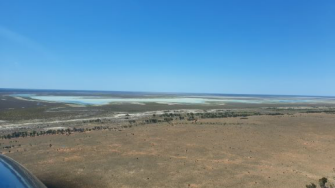
Date: Friday, October 4, 2019
Project: Eastern Australian Waterbird Survey
Observers: John Porter & Shannon Dundas
Trainee: Amelia Selles
Pilot: Tim Dugan
Todays flight leg is a big one – so we head out to Mt Isa airport in the pre-dawn for an early start, prepping the plane for a big days counting.
Pre dawn flight prep.
Departing Mt Isa just before dawn we fly pas the iconic Mt Isa mine, heading south to the western extremity of survey band 9.
One of the first big river systems we survey today is the Georgina River – there are still a few traces of water from the February floods but we have to work hard to find the last pools, hidden in the braided channels. There are very few waterbirds in this part of river – most have left when the water dried back.
The Diamantina River is next big river floodplain we encounter – and the conditions are similar to the Georgina; most of the water has gone and there are only a few trace puddles here and there in the vast network of braided channels. After this we survey the Thompson River which is also very dry with few waterbirds to report.
We land at Winton to refuel and stretch our legs – the next leg is a long one but the team is excited about what we will find at Lake Galilee – one of the most important wetlands in Queensland.
We head into Lake Galilee which is only partly full and is drying back – a spectacular mix of brackish and fresh water. There are huge areas of shallow water and muddy flats – nirvana for waterbirds, and we are not disappointed as vast numbers of grey teal, coot, cormorants, pelicans, pink eared ducks, avocets and stilts take to the air.
We work our way around the convoluted shorelines counting rapidly into our recorders – there must be more than 50,000 waterbirds on the lake and its one of the highlights of the trip so far.
Continuing eastward we pass north of Clermont and Dysart, counting whatever small wetlands we can find with water and recording those that are dry. After the highs of Lake Galilee we are back to counting low numbers of waterbirds in a dry landscape. Finally we make it to the end of the survey band south of St Lawrence and then head to Rockhampton to overnight. It’s one of the longest legs of the survey at nearly 5 hours and we have covered more than 1,790 km today.
